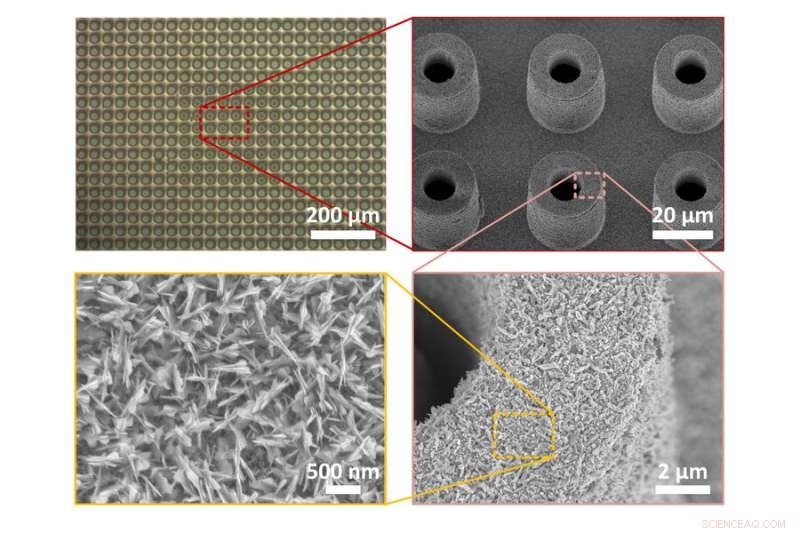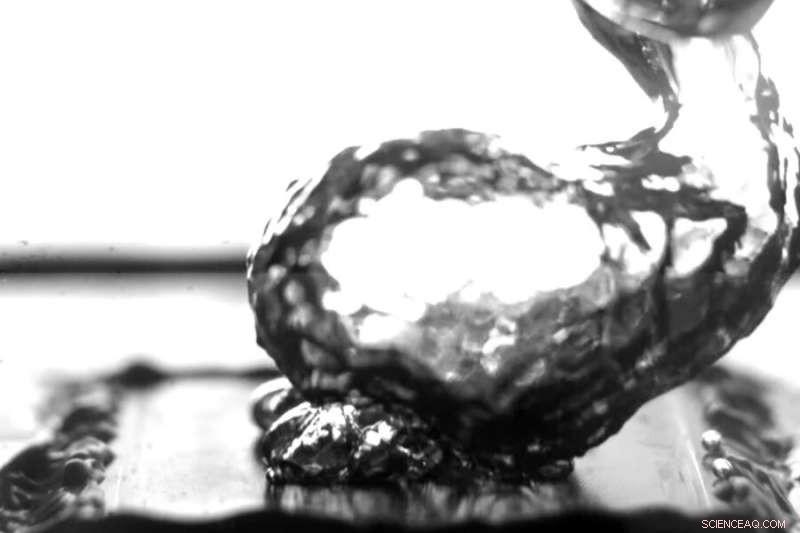
Nyckeln till den nya ytbehandlingen är att lägga till texturer i flera olika storleksskalor. Elektronmikroskopbilder visar pelare och bucklor i millimeterskala (de två första bilderna), vars ytor är täckta med små nanometerskala åsar (de två nedre bilderna) för att förbättra effektiviteten av kokreaktionen. Kredit:Massachusetts Institute of Technology
Kokning av vatten eller andra vätskor är ett energikrävande steg i hjärtat av en lång rad industriella processer, inklusive de flesta elproduktionsanläggningar, många kemiska produktionssystem och till och med kylsystem för elektronik.
Att förbättra effektiviteten hos system som värmer och förångar vatten kan avsevärt minska deras energianvändning. Nu har forskare vid MIT hittat ett sätt att göra just det, med en specialanpassad ytbehandling för materialen som används i dessa system.
Den förbättrade effektiviteten kommer från en kombination av tre olika typer av ytmodifieringar, i olika storleksskalor. De nya rönen beskrivs i tidskriften Advanced Materials i en artikel av nyligen utexaminerad MIT Youngsup Song Ph.D. '21, Ford Professor of Engineering Evelyn Wang, och fyra andra vid MIT. Forskarna noterar att detta första fynd fortfarande är i laboratorieskala, och mer arbete krävs för att utveckla en praktisk process i industriell skala.
Det finns två nyckelparametrar som beskriver kokningsprocessen:värmeöverföringskoefficienten (HTC) och det kritiska värmeflödet (CHF). Inom materialdesign finns det i allmänhet en avvägning mellan de två, så allt som förbättrar en av dessa parametrar tenderar att göra den andra värre. Men båda är viktiga för systemets effektivitet, och nu, efter år av arbete, har teamet uppnått ett sätt att avsevärt förbättra båda egenskaperna samtidigt, genom deras kombination av olika texturer som lagts till ett materials yta.
"Båda parametrarna är viktiga", säger Song, "men att förbättra båda parametrarna tillsammans är lite knepigt eftersom de har en inneboende avvägning." Anledningen till det, förklarar han, är "för om vi har många bubblor på den kokande ytan, betyder det att kokningen är mycket effektiv, men om vi har för många bubblor på ytan kan de smälta samman, vilket kan bilda en ånga. film över kokytan." Den filmen introducerar motstånd mot värmeöverföringen från den varma ytan till vattnet. "Om vi har ånga mellan ytan och vattnet, förhindrar det värmeöverföringseffektiviteten och sänker CHF-värdet", säger han.
Song, som nu är postdoc vid Lawrence Berkeley National Laboratory, utförde mycket av forskningen som en del av sitt doktorsavhandlingsarbete vid MIT. Medan de olika komponenterna i den nya ytbehandlingen han utvecklade hade studerats tidigare, säger forskarna att detta arbete är det första som visar att dessa metoder kan kombineras för att övervinna kompromissen mellan de två konkurrerande parametrarna.
Att lägga till en serie hålrum i mikroskala, eller bucklor, på en yta är ett sätt att kontrollera hur bubblor bildas på den ytan, hålla dem effektivt fästa vid bucklornas lägen och förhindra att de sprids ut till en värmebeständig film. I detta arbete skapade forskarna en uppsättning 10 mikrometer breda bucklor åtskilda med cirka 2 millimeter för att förhindra filmbildning. Men den separationen minskar också koncentrationen av bubblor vid ytan, vilket kan minska kokningseffektiviteten. För att kompensera för det introducerade teamet en ytbehandling i mycket mindre skala, vilket skapade små stötar och åsar på nanometerskalan, vilket ökar ytan och främjar avdunstningshastigheten under bubblorna.
I dessa experiment gjordes hålrummen i mitten av en serie pelare på materialets yta. These pillars, combined with nanostructures, promote wicking of liquid from the base to their tops, and this enhances the boiling process by providing more surface area exposed to the water. In combination, the three "tiers" of the surface texture—the cavity separation, the posts, and the nanoscale texturing—provide a greatly enhanced efficiency for the boiling process, Song says.

Photo shows how bubbles rising from a heated surface are “pinned” in specific locations because of special surface texturing, instead of spreading out over the whole surface. Credit:Massachusetts Institute of Technology
"Those micro cavities define the position where bubbles come up," he says. "But by separating those cavities by 2 millimeters, we separate the bubbles and minimize the coalescence of bubbles." At the same time, the nanostructures promote evaporation under the bubbles, and the capillary action induced by the pillars supplies liquid to the bubble base. That maintains a layer of liquid water between the boiling surface and the bubbles of vapor, which enhances the maximum heat flux.
Although their work has confirmed that the combination of these kinds of surface treatments can work and achieve the desired effects, this work was done under small-scale laboratory conditions that could not easily be scaled up to practical devices, Wang says. "These kinds of structures we're making are not meant to be scaled in its current form," she says, but rather were used to prove that such a system can work. One next step will be to find alternative ways of creating these kinds of surface textures so these methods could more easily be scaled up to practical dimensions.
"Showing that we can control the surface in this way to get enhancement is a first step," she says. "Then the next step is to think about more scalable approaches." For example, though the pillars on the surface in these experiments were created using clean-room methods commonly used to produce semiconductor chips, there are other, less demanding ways of creating such structures, such as electrodeposition. There are also a number of different ways to produce the surface nanostructure textures, some of which may be more easily scalable.
There may be some significant small-scale applications that could use this process in its present form, such as the thermal management of electronic devices, an area that is becoming more important as semiconductor devices get smaller and managing their heat output becomes ever more important. "There's definitely a space there where this is really important," Wang says.
Even those kinds of applications will take some time to develop because typically thermal management systems for electronics use liquids other than water, known as dielectric liquids. These liquids have different surface tension and other properties than water, so the dimensions of the surface features would have to be adjusted accordingly. Work on these differences is one of the next steps for the ongoing research, Wang says.
This same multiscale structuring technique could also be applied to different liquids, Song says, by adjusting the dimensions to account for the different properties of the liquids. "Those kinds of details can be changed, and that can be our next step," he says. + Utforska vidare
This story is republished courtesy of MIT News (web.mit.edu/newsoffice/), a popular site that covers news about MIT research, innovation and teaching.